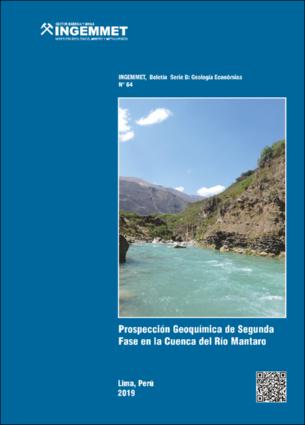Please use this identifier to cite or link to this item:
https://hdl.handle.net/20.500.12544/2394Files in This Item:
| File | Description | Size | Format | |
|---|---|---|---|---|
| B-064-Prospeccion_geoquimica_cuenca_rio_Mantaro.pdf | Boletín INGEMMET Serie B, n° 64 | 36.16 MB | Adobe PDF | View/Open |
| B064-MAF-GE36_3-16-01.pdf | Mapa Anomalías espectrales | 20.29 MB | Adobe PDF | View/Open |
| B064-MAF-GE36_3-16-02.pdf | Mapa Ubicación de muestras de sedimento del sector norte | 5.12 MB | Adobe PDF | View/Open |
| B064-MAF-GE36_3-16-03.pdf | Mapa Ubicación de muestras de sedimento del sector centro | 9.58 MB | Adobe PDF | View/Open |
| B064-MAF-GE36_3-16-04.pdf | Mapa Ubicación de muestras de sedimento del sector sur | 10.23 MB | Adobe PDF | View/Open |
| B064-MAF-GE36_3-16-05.pdf | Mapa Distribución del potencial de hidrógeno en estaciones de muestreo | 22.68 MB | Adobe PDF | View/Open |
| B064-MAF-GE36_3-16-06.pdf | Mapa Distribución de la conductividad eléctrica en estaciones de muestreo | 22.75 MB | Adobe PDF | View/Open |
| B064-MAF-GE36_3-16-07.pdf | Mapa Dispersión geoquímica secundaria de As | 21.82 MB | Adobe PDF | View/Open |
| B064-MAF-GE36_3-16-08.pdf | Mapa Dispersión geoquímica secundaria de Cu | 11.08 MB | Adobe PDF | View/Open |
| B064-MAF-GE36_3-16-09.pdf | Mapa Dispersión geoquímica secundaria de Cr | 10 MB | Adobe PDF | View/Open |
| B064-MAF-GE36_3-16-10.pdf | Mapa Dispersión geoquímica secundaria de Hg | 21.79 MB | Adobe PDF | View/Open |
| B064-MAF-GE36_3-16-11.pdf | Mapa Dispersión geoquímica secundaria de Mo | 21.79 MB | Adobe PDF | View/Open |
| B064-MAF-GE36_3-16-12.pdf | Mapa Dispersión geoquímica secundaria de Ni | 10.02 MB | Adobe PDF | View/Open |
| B064-MAF-GE36_3-16-13.pdf | Mapa Dispersión geoquímica secundaria de Au | 10.03 MB | Adobe PDF | View/Open |
| B064-MAF-GE36_3-16-14.pdf | Mapa Dispersión geoquímica secundaria de Ag | 10.02 MB | Adobe PDF | View/Open |
| B064-MAF-GE36_3-16-15.pdf | Mapa Dispersión geoquímica secundaria de Pb | 9.5 MB | Adobe PDF | View/Open |
| B064-MAF-GE36_3-16-16.pdf | Mapa Dispersión geoquímica secundaria de Zn | 9.51 MB | Adobe PDF | View/Open |
This item is licensed under a Creative Commons License












